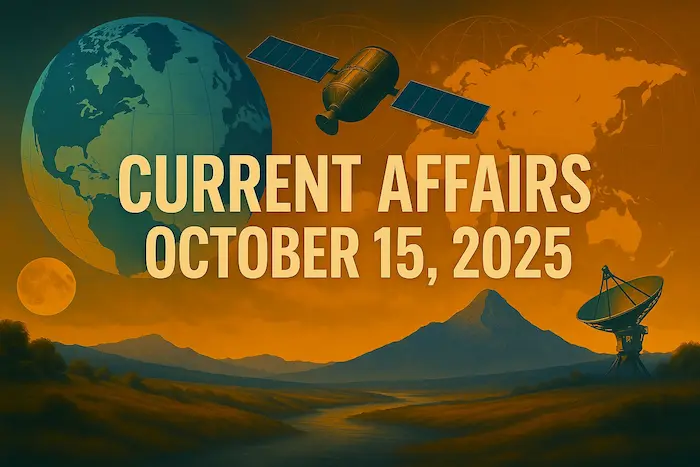1. Integrated Alert System – SACHET – Governance
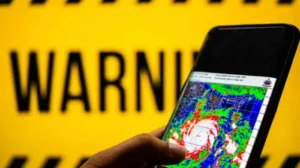
Why in News?
During the G20 Ministerial Meeting on Disaster Risk Reduction (DRR) in Durban, India’s Principal Secretary to the Prime Minister showcased the Integrated Alert System – SACHET, highlighting India’s advancements in early warning systems and disaster communication technologies.
Key Details
SACHET stands for an early warning system developed under the National Disaster Management Authority (NDMA).
It is designed to deliver real-time, geo-targeted alerts to citizens about impending natural disasters (like floods, earthquakes, cyclones, etc.).
Developed by the Centre for Development of Telematics (C-DOT).
Operates using the Common Alerting Protocol (CAP), a global standard recommended by the International Telecommunication Union (ITU).
Communication Technologies Used
SACHET ensures wide outreach through multiple communication platforms:
SMS
Cell Broadcast
Mobile App Notifications
Television & Radio Broadcasts
Social Media Updates
RSS Feeds
Browser Notifications
Satellite Communications
User-Friendly Features
Citizens can receive alerts based on their current GPS location or subscribe to specific states/districts.
The SACHET Mobile App provides:
Government-authenticated warnings.
Weather forecasts and alerts from the Indian Meteorological Department (IMD).
National Coverage
Operational across all States and Union Territories in India.
Plays a critical role in ensuring early evacuation, minimizing casualties, and improving disaster preparedness.
Exam Connect – Possible Questions
Prelims
1. The Integrated Alert System “SACHET” is primarily aimed at:
A. Promoting financial literacy among rural populations
B. Providing early warnings during disaster events
C. Curbing cybercrime in urban areas
D. Monitoring air pollution in metro cities
Answer: B. Providing early warnings during disaster events
2. Which of the following institutions developed the SACHET early warning platform?
A. Indian Space Research Organisation (ISRO)
B. National Informatics Centre (NIC)
C. Centre for Development of Telematics (C-DOT)
D. Defence Research and Development Organisation (DRDO)
Answer: C. Centre for Development of Telematics (C-DOT)
Mains
1. Examine the role of technology in strengthening disaster preparedness in India with reference to the Integrated Alert System (SACHET).
2. Discuss how platforms like SACHET contribute to inclusive governance and public safety during emergencies.
2. Snow Leopards: The World’s Least Genetically Diverse Big Cat – Environment

Why in News?
A Stanford University-led study has found that Snow Leopards possess the lowest genetic diversity among all big cats—even lower than the cheetah, which was previously considered the most genetically vulnerable.
This finding raises concerns about the species’ long-term survival, adaptability, and conservation strategies.
Key Biological and Ecological Features
Known as the “Ghost of the Mountains” due to their elusive nature.
Belong to the genus Panthera but are genetically distinct from other big cats like tigers and leopards.
Highly adapted to alpine and subalpine ecosystems.
Physical Adaptations:
Thick, pale-gray fur with rosettes for camouflage.
Powerful hind limbs for high-altitude leaping.
Long, thick tail for balance and warmth.
Habitat & Distribution
Altitude Range:
Thrive between 3,000 to 5,500 metres above sea level.
In India:
Found in: Ladakh, Himachal Pradesh, Uttarakhand, Sikkim, Arunachal Pradesh, and Jammu & Kashmir.
Globally:
Found in the Himalayas, Tien Shan, Pamir, and Altai mountain ranges across 12 range countries.
Population Estimates
Global population: ~4,500–7,500 individuals.
India: ~718 individuals (10–15% of global population).
Conservation Status
| Organisation/Act | Status |
|---|---|
| IUCN Red List | Vulnerable |
| CITES | Appendix I |
| Wildlife (Protection) Act, 1972 | Schedule I |
National Conservation Initiatives
Project Snow Leopard (2009):
Community-based conservation in Himalayan regions.
SECURE Himalaya (GEF–UNDP):
Promotes sustainable ecosystems and livelihood options.
Himalaya Sanrakshak (2020):
Engages local guardians for high-altitude biodiversity protection.
National Protocol on Population Assessment (2019):
Provides a scientific framework for monitoring snow leopards.
Ecological Significance
Apex Predator: Controls herbivore populations (blue sheep, ibex), maintaining ecosystem balance.
Indicator Species: Signals ecosystem health and connectivity.
Climate Regulation:
Alpine grasslands and glaciers in their habitat act as carbon sinks.
These landscapes regulate water flow for nearly 2 billion people across Asia.
Cultural & Economic Importance
Revered in Himalayan folklore and Buddhist traditions.
Central to eco-tourism and community-led conservation economies.
Transboundary Significance
Habitat spans 12 countries, making snow leopards a flagship species under the
Global Snow Leopard & Ecosystem Protection Programme (GSLEP).Promote international cooperation for biodiversity conservation across borders.
Exam Connect – Possible Questions
Prelims
1. With reference to Snow Leopards, consider the following statements:
1.They are listed as Endangered on the IUCN Red List.
2.Their habitat in India includes Himachal Pradesh and Arunachal Pradesh.
3.Project Snow Leopard is a community-based conservation initiative.
Which of the statements given above are correct?
A. 1 and 2 only
B. 2 and 3 only
C. 1 and 3 only
D. 1, 2 and 3
Answer: B. 2 and 3 only
(Note: They are classified as Vulnerable, not Endangered.)
2. Which of the following conservation initiatives in India is specifically aimed at preserving the snow leopard and its habitat?
A. Project Tiger
B. Himalaya Sanrakshak
C. Green India Mission
D. CAMPA
Answer: B. Himalaya Sanrakshak
Mains
1. Discuss the ecological and strategic importance of Snow Leopards in India’s alpine ecosystems.
2. Analyze the challenges in conserving genetically vulnerable species like the Snow Leopard, and evaluate India’s policy and institutional response to these challenges.
3. Delhi Morphological Ridge Designated as Reserved Forest – Geography
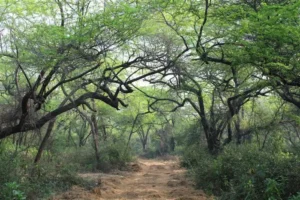
Why in News?
The Delhi Government has decided to declare 41 sq. km of the Southern Ridge as a Reserved Forest under the Indian Forest Act, 1927, in compliance with long-standing directives from the National Green Tribunal (NGT).
This marks a significant step in protecting Delhi’s ecological backbone and curbing urban encroachment.
What is the Delhi Ridge?
The Delhi Ridge is the northernmost extension of the Aravalli Hills.
It stretches ~35 km from Tughlaqabad in the south to Wazirabad in the north, running along the Yamuna River.
Made primarily of quartzite rock, the Ridge is geologically over 1.5 billion years old, far older than the Himalayas.
Zonation of the Ridge
The Ridge is divided into four zones:
Northern Ridge
Central Ridge
South-Central Ridge
Southern Ridge – currently proposed for reserved forest status.
Key Biodiversity Areas:
Northern Ridge Biodiversity Park
Asola Bhatti Wildlife Sanctuary
Ecological Significance
“Green Lungs” of Delhi: Critical in regulating temperature and improving air quality.
Carbon Sink: Helps in carbon sequestration and reducing urban heat.
Natural Barrier: Blocks desert winds from western Rajasthan.
Biodiversity Hotspot: Supports diverse flora and fauna; Delhi is among the world’s richest capitals in bird species.
Legal and Administrative Aspects
Despite its ecological value, much of the Ridge has not been officially notified as forest land, though it enjoys judicial protection.
A 1966 notification bars any non-forest use or development without court approval.
Land Use Regulation:
Any change in use needs clearance from:
Ridge Management Board (RMB)
Central Empowered Committee (CEC) of the Supreme Court
Revenue Records: Often marked as “gair mumkin pahad” (uncultivable rocky hill).
Ground-Truthing Needed: The final notification is pending field verification.
Geological Significance of the Aravalli Range
One of the oldest mountain ranges in the world.
Formed in the Precambrian era, estimated to be 1.5 to 2 billion years old.
Much older than the Himalayas, which are about 50 million years old.
Plays a key role in Indian subcontinent geology and ecology.
Exam Connect – Possible Questions
Prelims
1. Consider the following statements about the Delhi Ridge:
1.It is an extension of the Satpura range.
2.It is composed primarily of quartzite rock.
3.It acts as a natural barrier to desertification in Delhi.
Which of the statements given above are correct?
A. 1 and 2 only
B. 2 and 3 only
C. 1 and 3 only
D. 1, 2 and 3
Answer: B. 2 and 3 only
2. The Aravalli Range is geologically estimated to be how old?
A. 370 million years
B. 470 million years
C. 570 million years
D.1.5 to 2 billion years
Answer: D. 1.5 to 2 billion years
Mains
1. Examine the ecological and urban significance of the Delhi Ridge. How can the designation of its Southern Ridge as a Reserved Forest aid sustainable urban development?
2. Discuss the geological importance of the Aravalli Range in the context of Indian physical geography. How does it influence climate and ecology in Northern India?
4. Gomti Rejuvenation Mission Launched – Environment
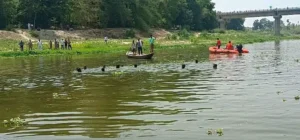
Why in News?
The Chief Minister of Uttar Pradesh has launched the ‘Gomti Rejuvenation Mission’, aimed at:
Restoring the ecological health of the Gomti River.
Ensuring continuous flow of water.
Intercepting 95% of urban sewage entering the river.
This mission is part of broader efforts to combat river pollution and promote sustainable water management.
Key Facts about the Gomti River
Tributary of: River Ganga (Ganges).
Length: ~900 km.
Basin Area: ~18,750 sq. km.
State: Flows entirely through Uttar Pradesh.
Origin and Course
Origin: Gomat Taal (Fulhaar Jheel) in Pilibhit District, Uttar Pradesh.
Flow Direction: Southward.
Merges with: The Ganga River near Saidpur in Ghazipur district.
Geological Characteristics
Basin is underlain by thick alluvial sediments:
Boulders, pebbles, gravel, sand, silt, clay, and kankars.
Alluvium is categorized into:
Younger alluvium (in active floodplains).
Older alluvium (on elevated terrain).
Flow Type: Perennial (flows throughout the year).
Sluggish flow during dry seasons.
High runoff during monsoon due to increased rainfall.
Major Cities on its Banks
Lucknow
Sultanpur
Jaunpur
Lakhimpur Kheri
Significant Tributaries
Sai River
Chowka River
Kathina River
Saryu River
Environmental Concerns
Urban Sewage Pollution: Major threat to river health.
Industrial Waste: Lack of treatment facilities in some urban zones.
Reduced Biodiversity: Due to declining water quality and habitat degradation.
Gomti Rejuvenation Mission – Objectives
Prevent untreated sewage from entering the river.
Develop and upgrade sewage treatment infrastructure.
Restore the natural floodplain and riparian ecosystems.
Promote public awareness and community participation in river conservation.
Exam Connect – Possible Questions
Prelims
1. Consider the following statements about the Gomti River:
1.It originates in Uttarakhand and flows into the Yamuna.
2.It is a tributary of the Ganga River.
3.Lucknow is located on its banks.
Which of the statements given above is/are correct?
A. 1 only
B. 2 and 3 only
C. 1 and 3 only
D. 1, 2 and 3
Answer: B. 2 and 3 only
2. Which of the following is not a tributary of the Gomti River?
A. Sai River
B. Kathina River
C. Saryu River
D. Betwa River
Answer: D. Betwa River
Mains
1. Examine the causes of river pollution in urban India with reference to the Gomti River. What measures are necessary to ensure long-term ecological restoration of polluted rivers?
2. Discuss the geomorphological and hydrological features of the Gomti River basin and their implications for urban planning and disaster management in Uttar Pradesh.
5. Anna Mani and Her Contributions to India’s Atmospheric Research – Science and Technology

Why in News?
The National Book Trust (NBT) has published a book celebrating Anna Mani’s pioneering contributions to India’s atmospheric and climate research. The book revisits her early work on ozone measurement and pollution studies in Pune, long before climate change became a global policy focus.
Who Was Anna Mani?
Born in 1918 in Peermade, Kerala.
An Indian physicist and meteorologist known for her pioneering work in:
Atmospheric instrumentation
Solar radiation and ozone monitoring
Standardization of weather instruments in India
Played a key role in transforming India’s meteorological services post-independence.
Worked with the India Meteorological Department (IMD).
Key Contributions to Atmospheric and Climate Science
1. Standardization of Meteorological Instruments
Instrumental in indigenizing weather instruments, reducing reliance on imports.
Contributed to precision engineering in:
Radiosondes
Barometers
Wind instruments
Ozone and solar radiation instruments
2. Ozone and Pollution Studies (1950s–60s)
Conducted early ozone layer measurements from Pune.
Studied atmospheric pollution well before it was acknowledged as a major global issue.
Contributed to long-term ozone data used for climate modeling.
3. Solar Radiation Measurement
Set up a network of radiation monitoring stations across India.
Her research is foundational to India’s current solar energy programs and climate models.
4. Leadership & Advocacy
Served as Deputy Director General at the IMD.
Advocated for scientific education for women and open-access data sharing in atmospheric sciences.
Legacy and Recognition
Known as the “Weather Woman of India”.
Helped lay the foundation for:
India’s environmental monitoring capacity
Climate science literacy
Her contributions are now being re-evaluated in light of the global climate crisis and India’s own climate commitments.
Exam Connect – Possible Questions
Prelims
1. Anna Mani is most well-known for her work in which of the following areas?
A. Nuclear physics
B. Meteorological instrumentation and ozone studies
C. Space exploration
D. Marine biology
Answer: B. Meteorological instrumentation and ozone studies
2. Which of the following statements is/are correct about Anna Mani?
1.She was a pioneer in ozone and solar radiation measurement in India.
2.She worked with the Indian Meteorological Department.
3.She contributed to India’s early nuclear policy.
Select the correct answer using the code below:
A. 1 and 2 only
B. 2 and 3 only
C. 1 and 3 only
D. 1, 2 and 3
Answer: A. 1 and 2 only
Mains
1. Anna Mani’s work laid the foundation for India’s modern atmospheric science. Discuss her contributions in the context of India’s preparedness for climate change and renewable energy planning.
2. Examine the role of Indian women scientists in advancing national scientific capabilities. Highlight the contributions of Anna Mani in meteorology and environmental monitoring.
6. India-Canada Relations Revived – International Relations
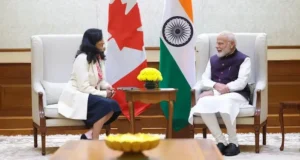
Why in News?
India and Canada have agreed to restore full diplomatic engagement and deepen cooperation in critical sectors such as trade, energy, agriculture, and technology, following a period of strained relations.
The move comes after a leadership change in Canada, with the new Prime Minister Mark Carney focusing on rebuilding trust and economic partnership with India.
Key Takeaways: India–Canada Relations
Historical Background
Diplomatic relations established in 1947.
Ties rooted in:
Shared democratic values
Commonwealth membership
People-to-people connections
Trade and Economic Cooperation
Bilateral Trade in 2024: Valued at $33.9 billion.
India imports from Canada:
Fertilizers
Pulses
Uranium and other energy products
India exports to Canada:
Pharmaceuticals
Textiles and garments
IT services and software solutions
Ongoing efforts to revive the Comprehensive Economic Partnership Agreement (CEPA) and facilitate investment flows.
Indian Diaspora in Canada
Over 1.6 million people of Indian origin, making it one of the largest immigrant groups in Canada.
Significant influence in:
Politics (several MPs and ministers)
Business
Academia
Over 300,000 Indian students currently enrolled in Canadian institutions.
Recent Diplomatic Tensions
In 2023, relations deteriorated following allegations linking the Indian government to the killing of a separatist leader on Canadian soil.
Consequences:
Suspension of trade talks
Diplomatic expulsions
Strained cultural and educational exchanges
Restoration & Strategic Cooperation
Under new leadership (PM Mark Carney), Canada is actively rebuilding ties with India.
Recent developments include:
Resumption of trade negotiations
Energy dialogue re-established, including clean energy cooperation
Civil nuclear cooperation continues under the 2010 agreement
Emphasis on technology innovation and sustainable agriculture
Global and Geopolitical Context
Both countries are:
G20 members
Commonwealth nations
Strategic players in Indo-Pacific diplomacy
Revival of relations is vital amid:
Global supply chain realignment
Climate change cooperation
Shifting economic alliances
Exam Connect – Possible Questions
Prelims
1. With reference to India-Canada relations, consider the following statements:
1.India imports uranium and pulses from Canada.
2.Canada is not a member of the G20 group.
3.Over 1 million Indian-origin people live in Canada.
Which of the above statements are correct?
A. 1 and 2 only
B. 2 and 3 only
C. 1 and 3 only
D. 1, 2 and 3
Answer: C. 1 and 3 only
(Canada is a G20 member, so Statement 2 is incorrect.)
2. The Comprehensive Economic Partnership Agreement (CEPA), currently under negotiation, is between India and:
A.Australia
B. Canada
C. USA
D. Germany
Answer: B. Canada
Mains
1. Examine the recent revival of India-Canada bilateral relations. What are the major challenges and opportunities in strengthening cooperation between the two nations?
2. How do diaspora communities influence bilateral relations? Discuss with reference to India-Canada ties.
7. A Green Transition Accelerating at Express Speed – Environment

Why in News?
India successfully conducted the trial run of its first hydrogen-powered train coach at the Integral Coach Factory (ICF) in July 2025.
This marks a major leap in Indian Railways’ goal to become net-zero in carbon emissions by 2030, aligning with India’s sustainable development goals and climate commitments.
Key Highlights of Indian Railways’ Green Transition
Net-Zero Target
Indian Railways aims to achieve net-zero carbon emissions by 2030 — a decade ahead of India’s national target (2070).
If successful, it could prevent the release of 60 million tonnes of CO₂ annually, equivalent to removing 13 million cars from Indian roads.
Electrification and Renewable Integration
Electrification Progress:
Over 45,000 km of broad-gauge routes have been electrified.
This accounts for 98% of the network, reducing reliance on diesel.
Renewable Energy Installations:
553 MW – Solar
103 MW – Wind
100 MW – Hybrid capacity
Over 2,000 railway stations now use solar power; some have achieved net-zero energy certification.
Hydrogen-Powered Trains
Under the “Hydrogen for Heritage” initiative:
35 hydrogen trains are planned to connect heritage and tourist routes.
Hydrogen traction offers a zero-emission alternative for non-electrified and sensitive routes.
Climate Finance and Green Bonds
The government has issued ₹58,000 crore in sovereign green bonds.
Funds are directed towards:
Electrification
Hydrogen rail innovation
Upgrading infrastructure with low-carbon technologies
Sustainable Infrastructure Development
Railway stations are being transformed into multi-modal transport hubs.
Freight services are adopting energy-efficient and electric locomotives.
Emphasis on public-private partnerships (PPPs) and green procurement.
Public Participation & Behavioral Change
Promotion of green certifications, eco-labeling, and awareness campaigns.
Efforts to involve passengers in sustainability goals through energy-efficient practices and eco-conscious travel behavior.
Exam Connect – Possible Questions
Prelims
1. Which of the following initiatives is associated with the deployment of hydrogen-powered trains in India?
A. Rail Vikas Abhiyan
B. Mission AMRIT
C. Hydrogen for Heritage
D. Green Tracks Initiative
Answer: C. Hydrogen for Heritage
2. Consider the following statements about Indian Railways’ green initiatives:
1.Over 98% of the broad-gauge network has been electrified.
2.The net-zero carbon emissions target for Indian Railways is 2050.
3.Indian Railways has installed more than 500 MW of solar capacity.
Which of the statements given above are correct?
A. 1 and 2 only
B. 1 and 3 only
C. 2 and 3 only
D. 1, 2 and 3
Answer: B. 1 and 3 only
(Statement 2 is incorrect: the net-zero target is 2030, not 2050.)
Mains
1. Indian Railways aims to achieve net-zero carbon emissions by 2030. Discuss the significance of this target and evaluate the key strategies adopted to achieve it.
2. Hydrogen-based transportation is being positioned as the future of clean mobility in India. Critically examine the viability of hydrogen trains in the Indian context.

